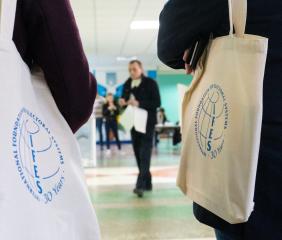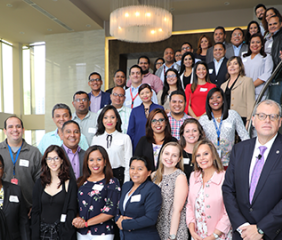Tools & Resources
Filter by
Type
Publication date
Language
Type
Publication date
Language
Publication
Survey
Public Opinion in Indonesia 2005
This survey assesses the public opinion environment in Indonesia a few months after the ascension of Susilo Yudhoyono to the presidency. The survey finds that economic matters are of greatest concern for the majority of Indonesians. While most Indonesians at the time of the survey express satisfaction with the administration of President Yudhoyono, a large majority of Indonesians do express dissatisfaction with his administration’s performance in job-creation and control of inflation. Nine in ten Indonesians say that the 2004 parliamentary and presidential elections were well-organized.
March 31, 2005
Publication
Report/Paper
Evaluation Report of Election Supervisors (2005)
Barely five years after the 1999 General Elections which marked the first democratic elections in Indonesia since 1955, another General Elections was held in 2004 which was expected to take a step farther the 1999 electoral exercises. Armed with new laws, regulations, and decrees to implement a new elections system; with the technical and financial support of the international community; with more enlightened and better equipped electoral management and supervisory bodies; and with the renewed hope and interest of civil society groups - the stakes were high and expectations were extraordinary that the 2004 elections would be a showcase of the new Indonesian democratic political process. In real terms and for the ordinary Indonesian citizens, why was the 2004 elections significant? Did they think that it would bring an improvement in their lives? The 2003 IFES survey in Indonesia revealed that the level of optimism regarding the economic and security conditions in the country decreased significantly since 2002. Just like previous IFES surveys in Indonesia, the economic situation remained the problem of greatest concern to majority of the citizens. Majority of Indonesians were also dissatisfied with the implementation of most aspects of the reform agenda. As a result of this, the people’s evaluation of the performance of government actions and of most national leaders and institutions plummeted. For instance, in 2003 – the height of elections preparations and the beginning of some of the stages of election implementation – 71% of the people thought that the government’s actions brought little or no improvement to the country. This was a rise in people’s dissatisfaction compared to 2002 which, although still high, was a bit lower at 66%. A majority of those aware of the presidency, DPR, and MPR were dissatisfied with performance of these institutions.
December 31, 2004
Publication
Report/Paper
Money and Politics in Indonesia – Vol. 6
Published in November 2004, this report focuses upon implementation in Indonesia’s 2004 elections of legal requirements for financial reporting by political parties and candidates. This report includes a discussion of political finance reporting requirements and reporting schedules, and describes the apparent extent of compliance by political parties and candidates with the basic disclosure requirements.
November 01, 2004
Publication
Survey
2004 Tracking Survey Results from Wave XVIII (October 2004)
Survey Implementation • This survey was conducted between 22 September and 29 September 2004, using face to face interviews with 1250 respondents in all 32 provinces. • Respondents were selected using multi stage random sampling of eligible voters. The composition of the respondents reflects the rural/urban, men/women and inter-provincial proportions of the Indonesian population. • The margin of error for the national data is +/-2.8% at a 95% level of confidence. • Data comparisons in the text relate to earlier IFES tracking surveys –Wave I: 13-18 December 2003; 1250 respondents; for national data +/-2.8% margin of error at 95% confidence level –Wave II: 12-15 January 2004; 1250 respondents; for national data +/-2.8% margin of error at 95% confidence level –Wave III/IV: 26 January –6 February 2004; 2000 respondents; for national data +/-2.2% margin of error at 95% confidence level –Wave V/VIII: 15 February –10 March 2004; 4000 respondents; for national data +/-1.55% margin of error at 95% confidence level –Wave IX: 21-28 March 2004; 1250 respondents; for national data +/-2.8% margin of error at 95% confidence level –Wave X: 7-14 April 2004; 1250 respondents; for national data +/2.8% marginof error at 95% confidence level –Wave XI/XII: 20 April -8 May 2004; 2000 respondents; for national data +/-2.2% margin of error at 95% confidence level –Wave XIII: 14 –9 June 2004; 1250 respondents; for national data +/-2.8% margin of error at 95% confidence level –Wave XIV: 17 –26 June 2004; 2000 respondents; for national data +/-2.2% margin of error at 95% confidence level –Wave XV: 7 –14 July 2004; 1250 respondents; for national data +/-2.8% margin of error at 95% confidence level –Wave XVI: 7 –14 August 2004; 1250 respondents; for national data +/-2.8% margin of error at 95% confidence level –Wave XVII: 2 –9 September 2004; 2000 respondents; for national data +/-2.2% margin of error at 95% confidence level • In this report, any data from the Wave I, Wave II, Waves III/IV,Waves V through VIII surveys, Wave IX, Wave X, Waves XI/XII, Wave XIII, Wave XIV Wave XV, Wave XVI, and Wave XVII is specifically cited in the charts and text. All other data points are from the Wave XVIII survey. Regional and other breakdowns reflect data from the Wave XVIII survey.
September 30, 2004
Publication
Survey
2004 Tracking Survey Results from Wave XVII (September 2004)
Survey Implementation • This survey was conducted between 2 September and 9 September 2004, using face to face interviews with 2000 respondents in all 32 provinces. • Interviews for this survey were completed before news of the bomb in front of the Australian Embassy on 9 September would have reached any but a very small proportion of respondents. This survey therefore does not take into account any impact the bombing may have had on opinions. • Respondents were selected using multi stage random sampling of eligible voters. The composition of the respondents reflects the rural/urban, men/women and inter-provincial proportions of the Indonesian population. • The margin of error for the national data is +/-2.2% at a 95% level of confidence. • Data comparisons in the text relate to earlier IFES tracking surveys – Wave I: 13-18 December 2003; 1250 respondents; for national data +/-2.8% margin of error at 95% confidence level – Wave II: 12-15 January 2004; 1250 respondents; for national data +/-2.8% margin of error at 95% confidence level – Wave III/IV: 26 January – 6 February 2004; 2000 respondents; for national data +/- 2.2% margin of error at 95% confidence level – Wave V/VIII: 15 February – 10 March 2004; 4000 respondents; for national data +/-1.55% margin of error at 95% confidence level – Wave IX: 21-28 March 2004; 1250 respondents; for national data +/-2.8% margin of error at 95% confidence level – Wave X: 7-14 April 2004; 1250 respondents; for national data +/2.8% margin of error at 95% confidence level – Wave XI/XII: 20 April - 8 May 2004; 2000 respondents; for national data +/-2.2% margin of error at 95% confidence level – Wave XIII: 14 – 9 June 2004; 1250 respondents; for national data +/-2.8% margin of error at 95% confidence level – Wave XIV: 17 – 26 June 2004; 2000 respondents; for national data +/- 2.2% margin of error at 95% confidence level – Wave XV: 7 – 14 July 2004; 1250 respondents ; for national data +/-2.8% margin of error at 95% confidence level – Wave XVI: 7 – 14 August 2004; 1250 respondents ; for national data +/-2.8% margin of error at 95% confidence level • In this report, any data from the Wave I, Wave II, Waves III/IV, Waves V through VIII surveys, Wave IX, Wave X, Waves XI/XII, Wave XIII, Wave XIV Wave XV, and Wave XVI is specifically cited in the charts and text. All other data points are from the Wave XVII survey. Regional and other breakdowns reflect data from the Wave XVII survey.
August 31, 2004
Publication
Survey
2004 Tracking Survey Results from Wave XV (August 2004)
Methodology • This survey was conducted between 7 July and 14 July 2004, using face to face interviews with 1250 respondents in all 32 provinces. • Respondents were selected using multi stage random sampling of eligible voters. The composition of the respondents reflects the rural/urban, men/women and inter-provincial proportions of the Indonesian population • The margin of error for the national data is +/-2.8% at a 95% level of confidence • Data comparisons in the text relate to earlier IFES tracking surveys – Wave I: 13-18 December 2003; 1250 respondents; +/-2.8% margin of error at 95% confidence level – Wave II: 12-15 January 2004; 1250 respondents; +/-2.8% margin of error at 95% confidence level – Wave III/IV: 26 January – 6 February 2004; 2000 respondents; +/- 2.2% margin of error at 95% confidence level – Wave V/VIII: 15 February – 10 March 2004; 4000 respondents; +/-1.55% margin of error at 95% confidence level – Wave IX: 21-28 March 2004; 1250 respondents; +/-2.8% margin of error at 95% confidence level – Wave X: 7-14 April 2004; 1250 respondents; +/2.8% margin of error at 95% confidence level – Wave XI/XII: 20 April to 8 May 2004; 2000 respondents; +/-2.2% margin of error at 95% confidence level – Wave XIII: 14 – 9 June 2004; 1250 respondents; +/-2.8% margin of error at 95% confidence level – Wave XIV: 17 – 26 June 2004; 2000 respondents; +/- 2.2% margin of error at 95% confidence level • In this report, any data from the Wave I, Wave II, Waves III/IV, Waves V through VIII surveys, Wave IX, Wave X, Waves XI/XII, Wave XIII and Wave XIV is specifically cited in the charts and text. All other data points are from the Wave XV survey. Regional and other breakdowns reflect data from the Wave XV survey.
July 31, 2004
Publication
Survey
2004 Tracking Survey Results from Wave XVI (August 2004)
Survey Implementation • This survey was conducted between 7 August and 14 August 2004, using face to face interviews with 1250 respondents in all 32 provinces. • Respondents were selected using multi stage random sampling of eligible voters. The composition of the respondents reflects the rural/urban, men/women and inter-provincial proportions of the Indonesian population. • The margin of error for the national data is +/-2.8% at a 95% level of confidence. • Data comparisons in the text relate to earlier IFES tracking surveys – Wave I: 13-18 December 2003; 1250 respondents; +/-2.8% margin of error at 95% confidence level – Wave II: 12-15 January 2004; 1250 respondents; +/-2.8% margin of error at 95% confidence level – Wave III/IV: 26 January – 6 February 2004; 2000 respondents; +/- 2.2% margin of error at 95% confidence level – Wave V/VIII: 15 February – 10 March 2004; 4000 respondents; +/-1.55% margin of error at 95% confidence level – Wave IX: 21-28 March 2004; 1250 respondents; +/-2.8% margin of error at 95% confidence level – Wave X: 7-14 April 2004; 1250 respondents; +/2.8% margin of error at 95% confidence level – Wave XI/XII: 20 April to 8 May 2004; 2000 respondents; +/-2.2% margin of error at 95% confidence level – Wave XIII: 14 – 9 June 2004; 1250 respondents; +/-2.8% margin of error at 95% confidence level – Wave XIV: 17 – 26 June 2004; 2000 respondents; +/- 2.2% margin of error at 95% confidence level – Wave XV: 7 – 14 July 2004; 1250 respondents ; +/-2.8% margin of error at 95% confidence level • In this report, any data from the Wave I, Wave II, Waves III/IV, Waves V through VIII surveys, Wave IX, Wave X, Waves XI/XII, Wave XIII, Wave XIV and Wave XV, is specifically cited in the charts and text. All other data points are from the Wave XVI survey. Regional and other breakdowns reflect data from the Wave XVI survey.
July 31, 2004
Election Material
Resolution
Constitutional Court Decision for DPD General Election Results Cases from Candidates
A summary of election dispute cases resolved by the Constitutional Court of Indonesia between May and June 2004.
Election Material
Resolution
Constitutional Court Decisions for DPR General Election Results
A summary of cases resolved in June 2004 following Indonesia's elections.
Publication
Survey
2004 Tracking Survey Results from Wave XIII (June 23, 2004)
Methodology • Waves I, II, IX, and X surveys were conducted using face-to-face interviews with 1250 respondents (each wave), selected by multi-stage random sampling of eligible voters throughout each of the 32 provinces of Indonesia. The Wave III survey was conducted in half the sampled locations throughout the country in 16 provinces with 1000 respondents, and the Wave IV survey was conducted in the rest of the sampled locations, in the other 16 provinces, with 1000 respondents. Each of the Waves V to VIII surveys were conducted in 8 different provinces with 1000 respondents in each Wave, for a national total of 4000 respondents covering all provinces. The Wave XI survey was conducted in half the sampled locations throughout the country in 16 provinces with 1000 respondents, and the Wave XII survey was conducted in the rest of the sampled locations, in 15 provinces, with 1000 respondents. The Wave XIII survey was conducted in 31 provinces with 1250 respondents. The province of Maluku was omitted fromthe Wave XII and Wave XIII surveys due to security problems. • The composition of the data in Wave I, Wave II, Waves III and IV combined, Waves V through VIII combined, Wave IX, Wave X, Waves XI and XII combined, and Wave XIII reflects the rural/urban, men/women and inter-provincial proportions of the Indonesian population. • The margin of error for the national data for each wave in Waves I, II, IX, X, and XIII is +/-2.8% at a 95% confidence level. The margin of error for each of the combined Waves III & IV, and Wave XI & XII data is +/-2.2% at a 95% confidence level. The margin of error for the combined Waves V through VIII data is +/-1.55% at a 95% confidence level. • For Wave I, the face-to-face interviews were conducted between 13 and 18 December 2003. For Wave II, the interviews were conducted between 12 and 15 January 2004. For Wave III, the interviews were conducted between January 26 and February 1. For Wave IV, the interviews were conducted between February 1 and 6. For Wave V, the dates of interviews were February 15-19; for Wave VI, February 21-25; for Wave VII, February 27-March 2; for Wave VIII, March 6-10 (the day before the commencement of the election campaign). For Wave IX, face-to-face interviews were conducted between March 21 and 28, 2004. For Wave X, face-to-face interviews were conducted between April 7 and 14, 2004. For Wave XI, face-to-face interviews were conducted between April 20 and 27. For Wave XII, face-to-face interviews were conducted between May 1 and 8. For Wave XIII, face-to-face interviews were conducted between June 4 and 9. • In this report, any data from the Wave I, Wave II, Waves III-IV, Waves V through VIII surveys, Wave IX, Wave X, Wave XI and XII combined is specifically cited in the charts and text. All other data points are from the Wave XIII survey. Regional breakdowns reflect data from the Wave XIII survey.
June 22, 2004



